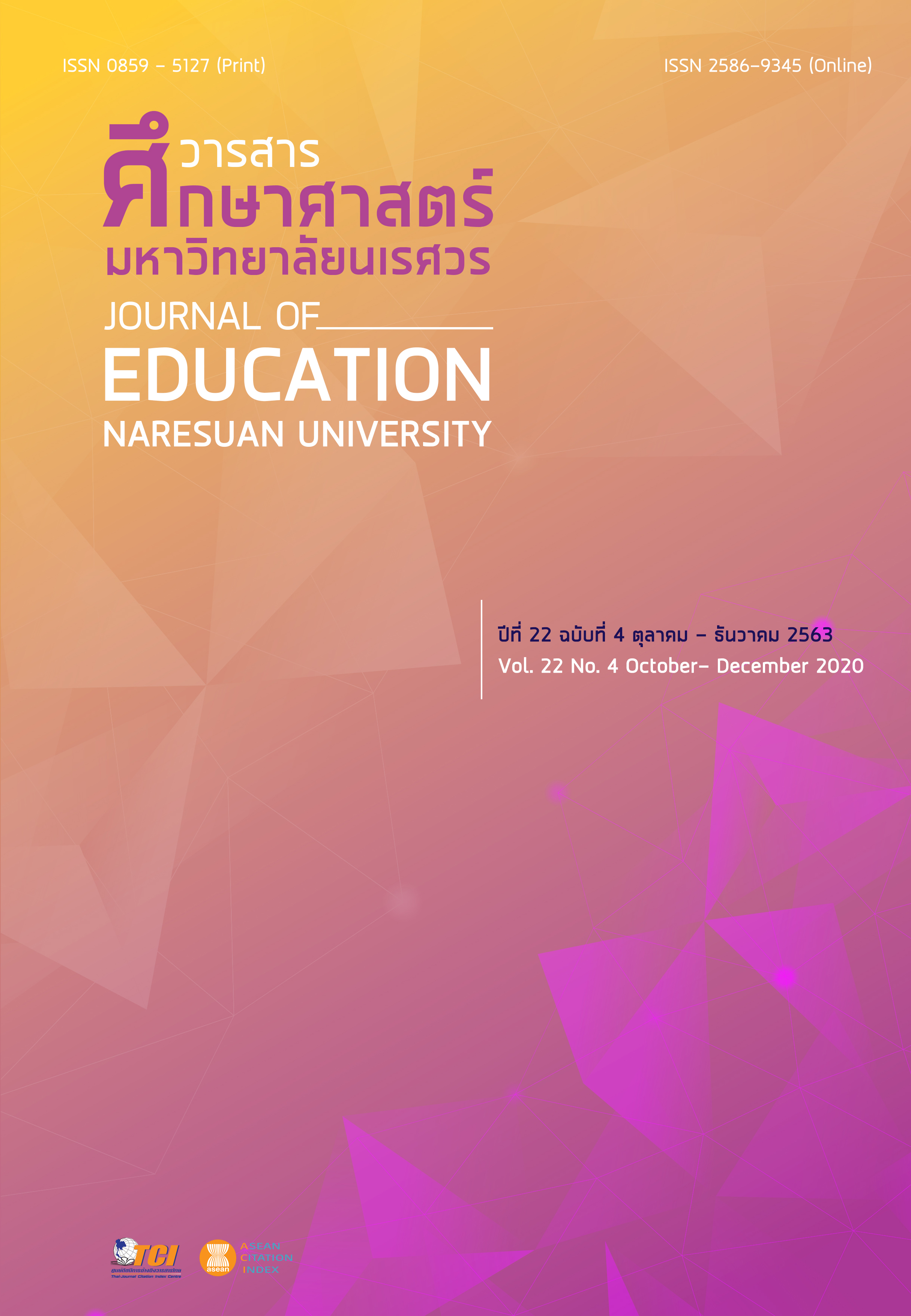EXPERT TEACHER’S VIEW ON TEACHING ABOUT CHEMICAL BONDING IN THAILAND 4.0 มุมมองของครูผู้เชี่ยวชาญต่อการสอนมโนทัศน์เรื่องพันธะเคมีในยุคประเทศไทย 4.0
Main Article Content
Abstract
This qualitative research aimed to investigate the expert teacher’s views on Teaching the chemical bonding concept. Data were collected through semi-structured interviews including five components of instructional about content, the objective of instruction, instruction activities, instruction materials, and learning
assessment. The development process semi-structured interview was examined by peer review and tried out. Data were analyzed using content analysis and was examined credibility by member checking and peer debriefing. The first finding indicates is the nature of chemical bonding is microscopics and abstract that difficult to see also the teacher should teach chemical bonding by 3D models to encourage students to visualize at the microscopic level. Second is teaching objective focus student’s understanding of physical and chemical properties of matter. The third is Instructional design based on scientific inquiry for students to create scientific representations by themselves. Fourth is should apply applications on mobile are
instructional media. Including learning assessment might use concept test and apply technologies that mainly students have been a more deep understanding.
Article Details
The owner of the article does not copy or violate any of its copyright. If any copyright infringement occurs or prosecution, in any case, the Editorial Board is not involved in all the rights to the owner of the article to be performed.
References
Bunkrong, D. (2017). Analysis of the education management approach with driving education to Thailand 4.0. Walailak Abode of Culture Journal, 17(2), 1-25. [in Thai]
Duangpummes, W., & Kaewurai, W. (2017). Learning management in Thailand 4.0 with active learning. Humanities and Social Sciences Journal of Graduate School, Pibulsongkram Rajabhat University, 11(2), 1-14. [in Thai]
Gabel, D. (1999). Improving teaching and learning through chemical education research: A look to the future. Journal of Chemical Education, 76, 548–554.
Gudyanga, E., & Madambi, T. (2014). students’ misconceptions about bonding and chemical structure in chemistry. Retrieved from http://ir.msu.ac.zw:8080/jspui/bitstream/11408/645/1/gudyanga2.pdf
Institute for the Promotion of Teaching Science and Technology. (2018). Innovation and technology in science instruction. Bangkok: Aksorncharoentat. [in Thai]
Johnstone, A. H. (1993). The development of chemistry teaching: A changing response to a changing demand. Journal of Chemical Education, 70(9), 701–705.
Kikuakul, S. (2018). Qualitative research: A distinguished paradigm and misconceptions. Journal of Education Naresuan University, 20(1), 272-283. [in Thai]
Kuathan, N. (2014). The development of secondary school students’ mental models of chemical bonding by model-based learning. Bangkok: Faculty of Education, Kasetsart University. [in Thai]
Levy Nahum, T., Mamlok‐Naaman, R., Hofstein, A., & Taber, K. S. (2010). Teaching and learning the concept of chemical bonding. Studies in Science Education, 46(2), 179-207.
Magnusson S., Krajcik J., & Borko H. (1999). Nature, sources, and development of pedagogical content knowledge for science teaching. In Gess-Newsome J., Lederman N. G. (eds) Examining Pedagogical Content Knowledge. Science & Technology Education Library, vol 6. Springer, Dordrecht. https://doi.org/10.1007/0-306-47217-1_4
Miles, M. B., & Huberman, A. M. (1994). Qualitative data analysis: An expanded sourcebook (2nd ed.). Sage Publications.
Saejueng, P., & Wuttisela, K. (2015). Science concept survey on covalent and ionic compounds of students learning through students team achievement division incorporated with chemical bonding cards. Journal of Research Unit on Science, Technology and Environment for Learning, 6(2), 108-208. [in Thai]
Schank, P., & Kozma, R. (2002). Learning chemistry through the use of a 13 representation based knowledge-building environment. Journal of Computers in Mathematics and Science Teaching, 21(3), 253–279.
Suttipong, R. (2017). A new paradigm in education and development of Thailand teachers in the digital age. Journal of Education Naresuan University, 19(2), 344-355. [in Thai]
Taber, K. S. (2003). Mediating mental models of metals: Acknowledging the priority of the learner's prior learning. Science Education, 87(5), 732-758.
Tan, K. D., & Treagust, D. F. (2001). Evaluating student’s understanding of chemical bonding. School Science Review, 81(294), 75-83.
Tasker, R., & Dalton, R. (2008). Visualizing the molecular world–Design, evaluation, and use of animations. In Visualization: Theory and practice in science education. Springer Netherlands.
Treagust, D. F., & Chittleborough, G. (2001). Chemistry: A matter of understanding representations. In J. Brophy (Ed.), Subject-specific instructional methods and activities (Vol. 8, pp. 239–267). Bingley, UK: Emerald Group. https://doi.org/10.1016/S1479-3687(01)80029-8
Yin, R. K. (2014). Case study research: Design and methods (5th ed.). Los Angeles: Sage Publications.


